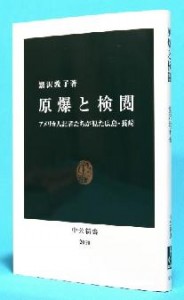Hiroshima writer seeks insight into U.S. coverage of A-bombings
Sep. 7, 2010
by Shinsaku Satao
How did reporters in the Allied countries, particularly the United States, convey the devastating consequences of the atomic bombings of Hiroshima and Nagasaki in the aftermath of World War II? What did they refrain from reporting? Atsuko Shigesawa, a freelance writer in Hiroshima, seeks to explore these questions in her book "The Atomic Bombings and Censorship."
Traditionally, only a handful of journalists, such as Wilfred Burchett, an Australian reporter, were thought to have come to the A-bombed cities to cover the story. In reality, though, more than ten reporters from major U.S. media outlets were dispatched to the cities as correspondents embedded with the Strategic Air Command (SAC) and wrote long articles. Some were issued earlier than the story written by Mr. Burchett, which had been considered the first report, but few were positioned as big news.
Ms. Shigesawa carefully tracked these articles in the newspapers and discovered a trend in the coverage. In particular, descriptions about the effect of radiation were often altered at the editing stage. Through changes to the text, these descriptions were negated.
In Japan, which was under the U.S.-led military occupation, the General Headquarters (GHQ) censored the Japanese media under the pretext of democratization. A range of writing about the atomic bombings was prohibited and such censorship was considered an extension of the censorship conducted in the United States through World War II. Ms. Shigesawa believes there were three main reasons why the coverage of the A-bombed cities was not accurately conveyed in the United States.
The first reason involved the effect of voluntary censorship, a common practice in the media during World War II. The U.S. army, which sought to control all aspects of the information related to the nation's nuclear development, continued to ask the media for its cooperation after the war.
The second reason stemmed from the patriotism of the reporters themselves. Due to the military censorship that took place during the war, an inclination developed to avoid reporting on any acts that could be considered a U.S. atrocity.
The third reason is connected to the arms buildup of the United States after World War II, in which the army, navy, and air force became engaged in gamesmanship over their standing within the U.S. military.
The title of the book's last chapter is "The Later Lives of Reporters Who Saw the A-bombed Cities." This chapter mentions the nagging rumor that Wilfred Burchett was actually a spy for the Soviet Union and that he was subject to some political pressure. Ms. Shigesawa concludes her book by saying that the most powerful censors were present in the minds of the journalists and the editors in the United States.
(Originally published on September 4, 2010)
How did reporters in the Allied countries, particularly the United States, convey the devastating consequences of the atomic bombings of Hiroshima and Nagasaki in the aftermath of World War II? What did they refrain from reporting? Atsuko Shigesawa, a freelance writer in Hiroshima, seeks to explore these questions in her book "The Atomic Bombings and Censorship."
Traditionally, only a handful of journalists, such as Wilfred Burchett, an Australian reporter, were thought to have come to the A-bombed cities to cover the story. In reality, though, more than ten reporters from major U.S. media outlets were dispatched to the cities as correspondents embedded with the Strategic Air Command (SAC) and wrote long articles. Some were issued earlier than the story written by Mr. Burchett, which had been considered the first report, but few were positioned as big news.
Ms. Shigesawa carefully tracked these articles in the newspapers and discovered a trend in the coverage. In particular, descriptions about the effect of radiation were often altered at the editing stage. Through changes to the text, these descriptions were negated.
In Japan, which was under the U.S.-led military occupation, the General Headquarters (GHQ) censored the Japanese media under the pretext of democratization. A range of writing about the atomic bombings was prohibited and such censorship was considered an extension of the censorship conducted in the United States through World War II. Ms. Shigesawa believes there were three main reasons why the coverage of the A-bombed cities was not accurately conveyed in the United States.
The first reason involved the effect of voluntary censorship, a common practice in the media during World War II. The U.S. army, which sought to control all aspects of the information related to the nation's nuclear development, continued to ask the media for its cooperation after the war.
The second reason stemmed from the patriotism of the reporters themselves. Due to the military censorship that took place during the war, an inclination developed to avoid reporting on any acts that could be considered a U.S. atrocity.
The third reason is connected to the arms buildup of the United States after World War II, in which the army, navy, and air force became engaged in gamesmanship over their standing within the U.S. military.
The title of the book's last chapter is "The Later Lives of Reporters Who Saw the A-bombed Cities." This chapter mentions the nagging rumor that Wilfred Burchett was actually a spy for the Soviet Union and that he was subject to some political pressure. Ms. Shigesawa concludes her book by saying that the most powerful censors were present in the minds of the journalists and the editors in the United States.
(Originally published on September 4, 2010)








